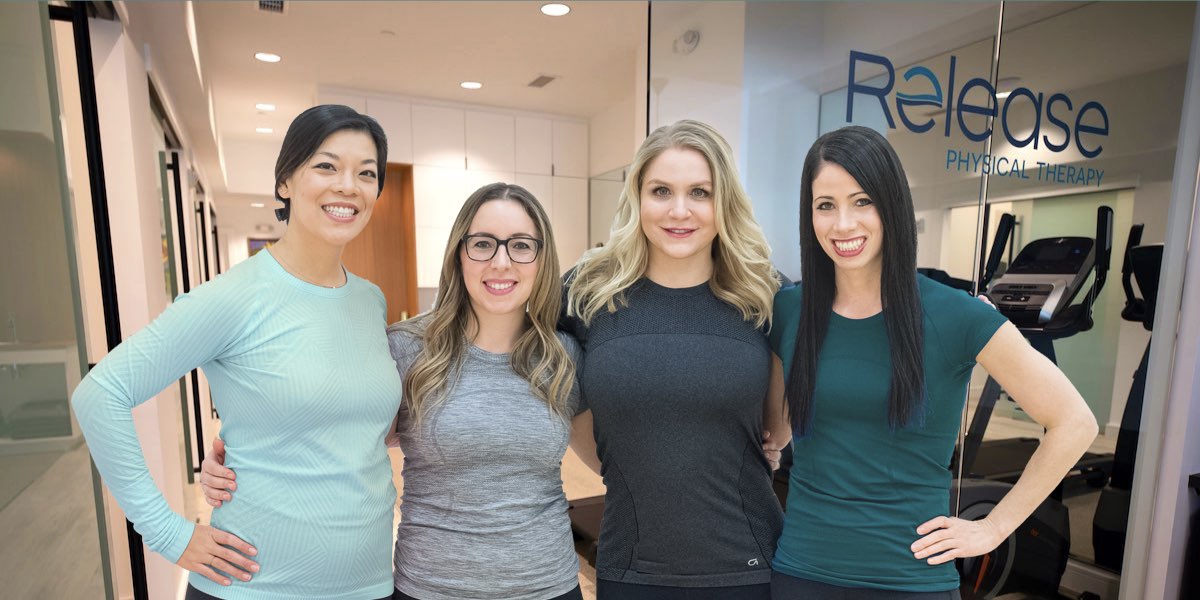
Physical Therapy for Knee Pain in Washington, D.C.
At Release Physical Therapy, our seasoned therapists perform comprehensive assessments to pinpoint the root causes of your knee pain problems. We then design individualized treatment plans aimed at promoting healing and relieving your specific issues.
Physical Therapy for Knee Pain in Washington, D.C.
At Release Physical Therapy, our seasoned therapists perform comprehensive assessments to pinpoint the root causes of your knee pain problems. We then design individualized treatment plans aimed at promoting healing and relieving your specific issues.
Book an appointment online with your preferred therapist at one of our convenient locations.
Release PTs have advanced training and experience in several techniques - including listening.
We use evidence-based therapies to target the root cause of a condition, not just the symptoms.
We'll help you get back to work, back in the game, and back to doing the activities you love.
Washington, D.C. Physical Therapy Treatment for Knee Pain
The Different Types of Knee Injuries: A Comprehensive Guide
A “physical therapy for knee pain near me” search has probably led you here, or perhaps you’re just curious about the different types of knee injuries and how they can affect our daily lives. Whatever your reason may be, this guide aims to provide a comprehensive overview of the various knee injuries that can occur. No fluff – just straight facts and information that you need to know.
Need immediate relief from knee pain? Don’t wait!
At Release Physical Therapy, we pride ourselves on being a hands-on physical therapy clinic, equipped with state-of-the-art facilities to aid your recovery process. Our specialized equipment includes advanced shockwave and laser technology designed to stimulate your body’s natural healing process. We employ methods like dry needling and deep tissue massages that go beyond just providing temporary relief. Each of our sessions lasts for 55 minutes, during which we deliver evidence-based therapies tailored to target the root cause of your knee pain. Our goal is to not only alleviate your immediate discomfort but also provide long-term solutions to prevent future injuries.
Let’s Understand the Knee First
Before diving into the different types of knee injuries, it’s important to have a basic understanding of the anatomy and function of the knee. The knee joint is made up of three bones:
- Femur (thigh bone)
- Tibia (shin bone)
- Patella (kneecap)
The function of the knee is to provide stability and mobility for daily activities such as walking, running, jumping, and squatting. The bones are connected by ligaments, which help to keep the joint in place, and cartilage which acts as a cushion between the bones. Other components of the knee include muscles, tendons, and bursae (small fluid-filled sacs) which all work together to support the joint.
Common Knee Injuries
Knee injuries can be classified into two main categories: acute and chronic. Acute injuries are caused by a sudden force or impact and can result in ligament sprains, muscle strains, fractures, or dislocations. On the other hand, chronic injuries are caused by repetitive stress on the joint over time and can lead to conditions such as tendonitis, bursitis, or osteoarthritis. Below are some of the most common knee injuries that we see and treat at Release Physical Therapy:
1) Knee Sprains and Knee Sprains
Knee sprains are one of the most common injuries and occur when the ligaments within the knee are stretched beyond their capacity. This can happen in various ways, such as a sudden change in direction while running or an unexpected stumble. Depending on the severity, knee sprains can be divided into three grades:
- Grade I: Mild damage to the ligament, but the knee is still able to function.
- Grade II: A partial tear of the ligament, causing the knee to become unstable.
- Grade III: A complete tear of the ligament, leading to significant instability and difficulty moving the knee.
Knee Strains refer to an injury to the muscles or tendons surrounding the knee. This could be due to overuse, improper use, or trauma. Strains are often characterized by pain, swelling, and difficulty in moving the knee. Similar to sprains, strains can also be categorized into three grades based on their severity.
2) Knee Fractures
A knee fracture is a break in one or more of the bones within the knee joint. This type of injury is often caused by high-impact trauma, such as a fall or direct blow to the knee. Knee fractures can vary in severity and require immediate medical attention for proper treatment. Some common symptoms include severe pain, swelling, inability to bear weight, and visible deformities.
3) Meniscus Tears
The meniscus is a piece of cartilage that acts as a shock absorber between the thighbone and shinbone. A tear can occur in the meniscus due to sudden twisting movements or degeneration over time. Symptoms of a meniscus tear include pain, swelling, stiffness, and difficulty in fully straightening the knee.
4) Knee Dislocation
A knee dislocation is a serious and rare injury that occurs when the bones of the knee are completely displaced from their normal position. This type of injury often requires immediate medical attention to reset the joint and address any damage to surrounding tissues. Symptoms may include severe pain, visible deformity, numbness or tingling in the leg, and an inability to move or bear weight on the affected knee.
5) Anterior Cruciate Ligament (ACL) Injuries
The ACL is one of the four main ligaments that stabilize the knee joint. It can be torn or sprained due to sudden stops, changes in direction, direct impact, or overuse. Symptoms of an ACL injury include a popping sound at the time of injury, severe pain, swelling, instability, and limited range of motion.
6) Posterior Cruciate Ligament (PCL) Injuries
The PCL is another important ligament in the knee that can be sprained or torn due to sudden impacts, overextension, or hyperflexion of the knee. Symptoms of a PCL injury may include pain, stiffness, swelling, and difficulty walking or bearing weight on the affected leg.
7) Kneecap Joint Irritation
The kneecap, also known as the patella, sits in front of the knee joint and plays a vital role in proper knee function. However, it is prone to irritation and injury due to repetitive movements or direct impact. Symptoms of kneecap joint irritation may include pain, swelling, stiffness, and difficulty straightening or bending the knee.
8) Tendonitis
Tendonitis in the knee is an inflammation or irritation of one or more tendons, the thick, fibrous cords that attach muscles to bones. This condition is usually caused by repetitive strain, sudden injury, or aging. Symptoms may include pain, swelling, and difficulty moving the knee.
9) Bursitis
Bursitis of the knee is an inflammation of the bursae, small fluid-filled sacs that cushion the knee joint. This condition can be caused by prolonged kneeling, direct impact, or repetitive strain. Symptoms may include pain, swelling, warmth, and limited range of motion.
10) Osteoarthritis
Osteoarthritis is a degenerative joint disease that can affect the knee. It involves the breakdown of the cartilage that cushions the ends of the bones in the knee joint. The main causes of osteoarthritis include aging, obesity, injury, and overuse. Symptoms typically include pain, stiffness, swelling, and decreased range of motion.
Experiencing the Advantages of Physical Therapy for Knee Pain with Release Physical Therapy
At Release Physical Therapy, we bring a hands-on approach to your knee pain management, offering a range of benefits that enhance your quality of life and physical well-being. We utilize state-of-the-art equipment, innovative techniques, and evidence-based therapies to target the root cause, not just the symptoms, of your knee pain.
- Improved Mobility: Regular physical therapy exercises, personalized to your needs, can help increase your range of motion and flexibility.
- Pain Reduction: We employ specific pain-alleviating modalities such as shockwave and laser therapies that can significantly reduce inflammation and discomfort in the knee.
- Enhanced Healing: Our therapy programs focus on promoting quicker healing by improving blood circulation to the injured area.
- Strengthening: We guide you through exercises aimed at strengthening the muscles surrounding the knee, providing better support and stability.
- Avoid Surgery: In many cases, our successful physical therapy regimens can help circumvent the need for invasive surgery.
- Preventing Recurrence: We don’t just treat; we educate. Our therapists will teach you proper body mechanics to prevent future injuries. Techniques like dry needling and deep tissue massage are part of our comprehensive approach to help you maintain a healthy, pain-free lifestyle.
Physical therapy at Release Physical Therapy also contributes to improved balance and coordination, increased endurance, and enhanced overall function and quality of life. Your journey toward a pain-free life starts here.
What is the best physical therapy for knee pain?
The best physical therapy for knee pain is one that is tailored to the individual’s unique needs and circumstances. At Release Physical Therapy, we pride ourselves on our hands-on approach and utilization of cutting-edge equipment. We employ shockwave therapy, which uses pressure waves to stimulate the body’s healing process, and laser therapy, known for its ability to reduce inflammation and pain.
Apart from these, we also specialize in unique modalities like dry needling, a technique aiming to stimulate underlying myofascial trigger points, and muscular, and connective tissues for the management of pain and movement impairments. Deep tissue massages are another key service we offer, targeting chronic muscle tension and helping to break up scar tissue that often develops after an injury and reduces the range of motion.
Lastly, we believe that the path to recovery does not end with treatment alone. We strive to provide our patients with the education they need to maintain their physical health, preventing the recurrence of injuries. Such techniques may include exercises, posture correction, and body mechanics training.
How long does physical therapy take for knee pain?
Anywhere from a few weeks to several months.
The length of time required for therapy to alleviate knee pain will depend on the nature of the injury, whether it’s a chronic condition like osteoarthritis or an acute injury like a torn ligament. Moreover, the patient’s overall health and fitness levels can influence how quickly they can recover.
At Release Physical Therapy, we provide intensive 55-minute sessions designed to optimize recovery time without compromising on the quality of care. These sessions allow ample time for different therapeutic techniques best suited for the patient’s condition and are always tailored to the individual’s unique needs and circumstances. Commitment outside of the therapy session also plays a large role in recovery. Following the prescribed at-home exercises and care can significantly accelerate healing and improve long-term outcomes.
Now Accepting New Patients
Feel Your Very Best
Whether you’re an athlete that plays hard on the field, or a weekend warrior that plays hard in life, committing to a physical therapy program can help to keep you moving forward.
Is physical therapy good for knee pain?
Yes, physical therapy has been proven to be an effective treatment for knee pain. Studies have shown that it can improve range of motion, reduce pain and inflammation, and increase muscle strength and stability around the joint. It may also help prevent future injuries by addressing underlying issues such as muscle imbalances or poor movement patterns.
Does physical therapy work for knee pain?
Yes, physical therapy is an effective and recommended treatment for knee pain. It can help reduce pain, improve function and mobility, and prevent future injuries. In fact, many doctors will often refer patients to physical therapy as a first-line treatment for knee pain before considering more invasive options such as surgery.
What exercises should you avoid with knee pain?
Individuals suffering from knee pain should avoid high-impact exercises that put excessive strain on the knee joint. These include activities such as running on hard surfaces, high-intensity interval training, deep squats, lunges, and any exercise involving jumping or abrupt changes in direction. Instead, it’s recommended to focus on low-impact physical therapy exercises for knee pain, such as stationary biking, swimming, or performing exercises that strengthen the quadriceps and hamstrings without aggravating the joint, like straight leg raises or seated leg extensions. Always consult a physical therapist before starting any new exercise regimen to ensure it’s safe and beneficial for your specific condition.
What do physical therapists do for knee pain?
Physical therapists at Release Physical Therapy utilize a variety of techniques for knee pain, designed to reduce discomfort and improve function. One such method is dry needling, a procedure that involves inserting a thin needle into specific muscle areas to alleviate pain, reduce muscle tension, and promote healing.
Another technique is deep tissue massage, which targets the deeper layers of muscles and connective tissues. It aids in alleviating chronic muscle tension, reducing inflammation, and promoting faster healing by increasing blood flow to the affected area.
We also recommend specific stretches and exercises tailored to your individual needs, focusing on strengthening the muscles surrounding the knee joint to improve stability and reduce pain.
What is the best exercise for knee pain?
Generally, low-impact exercises such as swimming, biking, and walking are recommended to improve strength and flexibility without causing excess strain on the knee joint. Strengthening exercises that target the quadriceps, hamstrings, and hip muscles can also be beneficial in reducing knee pain and preventing future injury. Moderate weight training, with a focus on proper form and technique, can also help build overall strength and stability in the knee joint. Always consult a physical therapist for knee pain for guidance on the best exercises for your specific condition.
Are there any stretches that can help with knee pain?
Yes, stretching is an important part of managing knee pain. Static stretches that target the quadriceps, hamstrings, and calves can help improve flexibility and reduce tension in the knee joint. Dynamic stretches that involve movement, such as leg swings or lunges, can also be beneficial in preparing the knee for physical activity.
Should you rest or walk with knee pain?
It is important to listen to your body and avoid activities that aggravate your knee pain. If you are experiencing severe pain or swelling, it may be beneficial to rest for a short period of time until the symptoms subside. However, complete rest for an extended period of time can actually weaken the muscles around the knee joint and delay healing. Low-impact activities such as walking or swimming can help maintain flexibility and strength without putting too much stress on the knee.
What triggers knee pain?
Knee pain can be triggered by a variety of factors, including overuse or repetitive movements, sudden impact or trauma, and underlying conditions such as arthritis or tendonitis. Poor posture and muscle imbalances can also contribute to knee pain. It is important to pay attention to any activities or movements that seem to worsen your knee pain to avoid further aggravation.
Don’t let knee pain hold you back – our physical therapy team is here to help you find relief and return to your favorite activities. We will first assess your individual needs and create a personalized treatment plan to address the root cause of your knee pain. Through modern techniques, specialized exercises, and education on proper body mechanics, we will work with you to rebuild strength and flexibility in the muscles surrounding your knee joint.
We offer our clients the flexibility to pick from our three centers located in West End/Foggy Bottom, downtown Washington, D.C., or Tyson’s Corner. Scheduling a session is as simple as making a phone call or using our user-friendly online booking tool on our website.
We'll help you get back to work, back in the game, and back to doing the activities you love.
Release Physical Therapy
Treatments
At Release Physical Therapy Washington, DC, we offer a full range of manual therapies, as well as both traditional and non-traditional techniques. We work one-on-one with our patients to develop an individualized treatment plan that meets their unique needs, conditions, wellness goals and fitness levels. Learn More
ASTYM ® Therapy
Regenerates healthy soft tissues (muscles, tendons, etc.), and eliminates or reduces unwanted scar tissue that may be causing pain or movement restrictions.
Functional Training
Exercise regimens that integrate multiple muscle groups, joints and the brain to prepare the body for everyday movement, athletics and other specialized physical activities.
Shockwave Therapy
A non-invasive, office based treatment that utilizes acoustic waves to alleviate pain, promote tissue regeneration, and accelerate the healing process.
Meet Washington DC's best
Physical Therapists
Our experienced and highly trained physical therapists specialize in treating the outpatient orthopedic population, including sports therapy, orthopedic/spinal therapy, chronic pain management, pre/post-surgical therapy, as well as wellness and prevention. All of our physical therapist are accepting new patients.
Meet Washington DC's Best
Physical Therapists
Monday - Thursday
6:00 am - 8:00 pm
Mon - Thur
6:00 am - 8:00 pm
Friday
6:00 am - 5:00 pm
Saturday
By appointment
Sunday
Office is closed
What Patients Are Saying
What Patients Say
"Dr. Simon's knowledge, expertise and patience have given me my life back. She spent more time discussing my injuries and recovery than both my doctor and an orthopedist." - L.J.
Health & Safety
Covid-19
At Release Physical Therapy, there is nothing more important to us than the health and safety of our patients and staff during this unprecedented time. The Department of Homeland Security and state governments have deemed physical therapy an essential component of healthcare during the coronavirus (COVID-19) pandemic; therefore, our office will remain open to serve those in need. We are taking extensive preventative measures to protect our patients and employees who enter our clinic. Learn more
Latest Blog Posts
The Right Way to Breathe: Understanding the Diaphragm and Pelvic Floor
A condition called FAI (femoral acetabular impingement syndrome) could be the cause of your hip pain. Learn the symptoms and how physical therapy may be able to help.
Understanding Urinary Incontinence: It’s Time to Break the Silence
A condition called FAI (femoral acetabular impingement syndrome) could be the cause of your hip pain. Learn the symptoms and how physical therapy may be able to help.
Can You Exercise During Pregnancy? The Answer Is, Absolutely.
Despite its name, tennis elbow is isn't just for tennis players. It’s a common ailment that can affect anyone who frequently uses their arm, forearm, and hand.
Follow us on Instagram!
Error: No feed found.
Please go to the Instagram Feed settings page to create a feed.
Location & Hours
Hours of Operation
Monday-Thursday: 6am - 8pm
Friday: 6am - 5pm
Saturday: By appointment
Sunday: Office closed
Office Address
Release Physical Therapy
2134 L St NW, Washington, DC 20037
Our Physical Therapists
Our experienced and highly trained physical therapists specialize in treating the outpatient orthopedic population, including sports therapy, orthopedic/spinal therapy, chronic pain management, pre/post-surgical therapy, as well as wellness and prevention. All of our physical therapists are accepting new patients.























